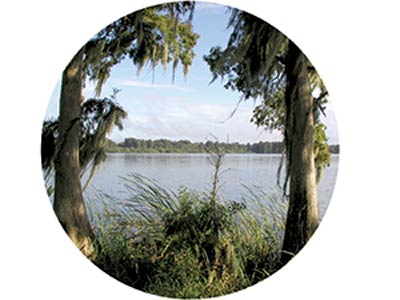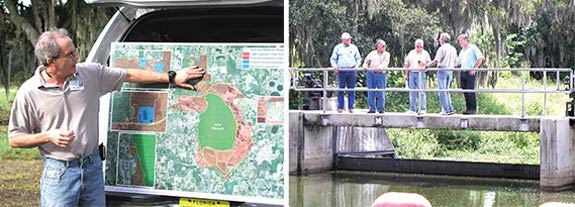Left: Mark Hammond, resource projects director, shows the Lake Hancock property and project areas. Right: District Governing Board members and staff visit the current outfall at Lake Hancock. (From left to right, Board Members Ron Oakley, Paul Senft and Carlos Beruff with District staff members Mark Hammond and Chuck Lane.)
District staff and Governing Board members recently toured Lake Hancock in Polk County for an update on the progress of several projects that will improve the overall health of the Peace River.
The Lake Hancock Lake Level Modification and Outfall Treatment projects include restoring minimum flows in the upper Peace River and improving water quality in the Peace River and Charlotte Harbor.
“The tour was a good opportunity for the newest Board members to see the lake for the first time and for the veteran members to see the lake’s current conditions,” said Lou Kavouras, deputy executive director for District Outreach, Planning & Board Services.
The Lake Hancock Lake Level Modification Project is designed to store water by raising the control elevation of the existing outflow structure on Lake Hancock and slowly release the water during the dry season to help meet the minimum flow requirements of the upper Peace River. Currently, the minimum flow requirements for the upper Peace River at Fort Meade are only being met approximately 70 percent of the time. The Lake Hancock Lake Level Modification Project is expected to provide low flows to increase the number of days the upper Peace River will meet the minimum flows from 70 percent to 87 percent.
The tour began at the Polk Nature Discovery Center at Circle B Bar Reserve in Polk County and made several stops along the way. Some of the locations included the recently acquired Hampton and Coscia tracts on the northeast side of the lake, which could serve as a future recreation area. The group also visited the existing outfall structure on Saddle Creek, which will be rebuilt to accommodate the higher lake level. In addition, attendants observed the outfall treatment project test cells on the south end of the lake.
The Outfall Treatment Project will improve water quality discharging from the lake and, in turn, will improve water quality in the Peace River and protect Charlotte Harbor. It is anticipated that an approximately 1,000-acre wetland treatment area will be constructed to reduce nitrogen loading to the Peace River and Charlotte Harbor by 27 percent annually.
To accomplish the Lake Hancock project goals, the acquisition of lands became a key component. Board members were able to learn about the current land acquisitions and future recreational opportunities available on these lands from Eric Sutton, land resources director.
To date, the District has acquired 7,173 acres in fee and 951 acres in less-than-fee for the project. An additional 81 acres have been identified for fee acquisition and 276 acres for less-than-fee acquisition. Lands in fee are District-owned, while less-than-fee is a public purchase of certain property rights from the landowner while leaving the property in private ownership.
The lands acquired for the Lake Hancock projects are expected to provide unique opportunities for public use and natural system management.
“The District recently completed a land use and management plan that focuses on opportunities for these lands such as recreation, restoration, water quality improvements, management partnership opportunities and linkages with other public lands,” said Sutton. “This plan was developed based on extensive input from stakeholder groups and interested public.”
Following the tour, Board members were better able to visualize the various land-use alternatives under consideration.


